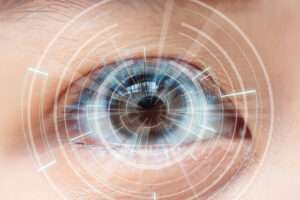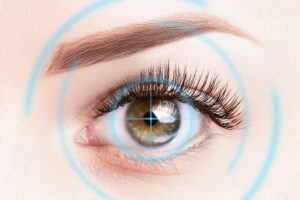
We ophthalmologists, and especially refractive surgeons, don’t have to go too many days in our clinics without seeing the damage that long term contact lens use can do to the eye. Far too frequently, patients will present with issues related to contact lens use, misuse, and overuse. These problems include but are certainly not limited to contact lens related corneal ulcers (keratitis) which can cause permanent corneal scarring and visual loss, and in some very unfortunate few, even loss of the eye. Pretty scary stuff, but since even the best contact lenses deprive the cornea of much needed oxygen, any defect in the surface cells of the cornea which may pre-exist or be created by the application and wear of a contact lens will provide an ideal environment on which bacteria may flourish. They only need to be introduced in reasonable numbers for this to happen, and a week-old contact lens that’s been stored in old saline, or worse yet, tap water, or never cleaned at all can provide the perfect inoculant.
Since it’s not realistic that all patients will exercise perfect precautions and hygiene when it comes to contact lens care, storage, cleaning and wear, we specialists have become all too familiar with the scary scenario seen here. Ironically enough, the very day after I wrote the above paragraph, an optometrist colleague of mine entered my office with a contact lens related corneal ulcer! So believe me, if it can happen to her, it can happen to you. Given the prevalence of contact lens related infections, it’s not surprising that 10 year contact lens wear data shows infection rates significantly higher than the rates associated with refractive surgery, which depending on the source show rates of roughly 1 in 10,000. To give you an idea of how rare it is to see one, I have never seen a refractive surgery related infection in any flap (Intralase or lasik) case at any of our Diamond Vision clinics in the past 8 years!
Of course, even if you have a perfect track record with contact lenses and are lucky enough never to have had a contact lens infection, there is no escape from the long-term consequences of depriving the cornea of oxygen, or the fact that a piece of plastic resting on one’s eye for years has negative consequences to the surrounding tissues with which it comes in contact. Plainly and simply, the body will make adjustments to try to accommodate this foreign object which restricts normal tear film movement on the ocular surface, and consequently oxygen diffusion. One of the ways the body does this is to build new blood vessels around and into the cornea. In order to do this, inflammatory signals and cells must be turned on, which aid in the building of these new blood vessels. Unfortunately, the body’s good intentions of getting oxygen to tissues that are deprived of it, in this case the cornea, is done at the cost of increased ocular surface inflammation, which in turn decreases the production of neighboring aqueous and oil glands as well as helpful mucin producing cells, all of which are designed to protect the cornea and provide a consistent, uniform ocular surface or “tear film”, which is critical to maintaining great vision. As a result, patients find themselves trapped in a vicious cycle where their visual acuity steadily worsens while their contact lens intolerance steadily increases. This set of symptoms is a common reason for patients to seek out a refractive surgeon these days. The natural tendency as a patient finds their eyes becoming more irritated is to rub them, and this only serves to increase inflammation all the more, as rubbing the eyes will stimulate the release of histamine (an inflammatory mediator) from neighboring mast cells found in the white part of the eye (conjunctiva). Of course, these issues are magnified even more nowadays, as more folks find themselves in front of a computer for hours on end, and studies have clearly shown that we will blink one third to even one fourth as often as normal when staring at a computer than doing something else, such as interacting with another person. The result of this is that we specialists are seeing a great increase in the prevalence of “evaporative dry eye”, where a patients tears break up before their next eyelid blink, causing repeat exposure of the cornea to outside air. Kinda make you want to talk to your friends a little more and perhaps stare at the computer a little less, right?!
Notwithstanding the above scary stuff, because a contact lens is still a piece of plastic, no matter how well it’s supposed to do its job, it does occupy space on the front surface of the cornea. As a result, the upper eyelid is pushed forward somewhat in order to close over this contact lens, and increased pressure is exerted on the oil glands found in the tarsal plate of the upper lid. Studies have shown that this relationship can cause attenuation of these oil (meibomian) glands over time, creating a mechanical reason for contact lens wearers to suffer from dry eyes, in addition to the physiologic reasons discussed above. Click here to read more about this.
This is why it’s not surprising that we Refractive specialists often hear from happy patients months after their refractive surgery, telling us how elated they are to be seeing better than they ever have, AND that they suffer far less symptoms of dryness and irritation then they did in their contact lenses. This is the result of restoring a normal anatomical and physiological relationship between the cornea, the ocular surface, and the eyelids. Read more here about parasites in contact lens. You can also contact our specialist at the Atlanta Laser Eye Surgery Center for more information.
Contact Us
If you have more questions about LASIK procedures, get in touch with us.
Related Blogs

Timing is Everything: When to Consider LASIK After Nursing for Optimal Results
Timing is everything when considering LASIK eye surgery after nursing, and understanding the optimal period for this procedure is vital for both mother and baby.

Cataract Surgery: Restoring Clarity and Confidence
Cataract surgery is a transformative procedure that offers a new lease on clear vision and renewed confidence. As cataracts cloud the eye’s lens, causing blurred

Intralase LASIK Explained: What to Expect Before, During, and After the Procedure
Intralase LASIK is a cutting-edge procedure that offers a safe, effective, and precise way to enhance vision compared to traditional LASIK methods. Understanding what to
